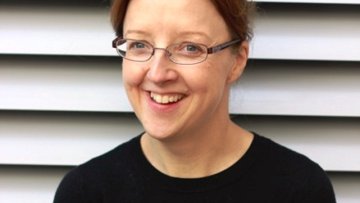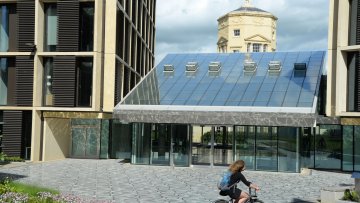Characterizing participation in online discussion platforms
Abstract
Online discussions are the essence of many social platforms on the Internet. Discussion platforms are receiving increasing interest because of their potential to become deliberative spaces. Although previous studies have proposed approaches to measure online deliberation using the complexity of discussion networks as a proxy, little research has focused on how these networks are affected by changes of platform features.
In this talk, we will focus on how interfaces might influence the network structures of discussions using techniques like interrupted time series analysis and regression discontinuity design. Futhermore, we will review and extend state-of-the-art generative models of discussion threads to explain better the structure and growth of online discussions.
Uniformity of integral points and moduli spaces of stable pairs
Abstract
Starting from the seminal paper of Caporaso-Harris-Mazur, it has been proved that if Lang's Conjecture holds in arbitrary dimension, then it implies a uniform bound for the number of rational points in a curve of general type and analogue results in higher dimensions. In joint work with Kenny Ascher we prove analogue statements for integral points (or more specifically stably-integral points) on curves of log general type and we extend these to higher dimensions. The techniques rely on very recent developments in the theory of moduli spaces for stable pairs, a higher dimensional analogue of pointed stable curves.
If time permits we will discuss how very interesting problems arise in dimension 2 that are related to the geometry of the log-cotangent bundle.
On the motive of the stack of vector bundles on a curve
Abstract
Following Grothendieck's vision that many cohomological invariants of of an algebraic variety should be captured by a common motive, Voevodsky introduced a triangulated category of mixed motives which partially realises this idea. After describing this category, I will explain how to define the motive of certain algebraic stacks in this context. I will then report on joint work in progress with Victoria Hoskins, in which we study the motive of the moduli stack of vector bundles on a smooth projective curve and show that this motive can be described in terms of the motive of this curve and its symmetric powers.
Multiscale mixing patterns in networks
Abstract
Assortative mixing in networks is the tendency for nodes with the same attributes, or metadata, to link to each other. It is a property often found in social networks manifesting as a higher tendency of links occurring between people with the same age, race, or political belief. Quantifying the level of assortativity or disassortativity (the preference of linking to nodes with different attributes) can shed light on the factors involved in the formation of links and contagion processes in complex networks. It is common practice to measure the level of assortativity according to the assortativity coefficient, or modularity in the case of discrete-valued metadata. This global value is the average level of assortativity across the network and may not be a representative statistic when mixing patterns are heterogeneous. For example, a social network spanning the globe may exhibit local differences in mixing patterns as a consequence of differences in cultural norms. Here, we introduce an approach to localise this global measure so that we can describe the assortativity, across multiple scales, at the node level. Consequently we are able to capture and qualitatively evaluate the distribution of mixing patterns in the network. We find that for many real-world networks the distribution of assortativity is skewed, overdispersed and multimodal. Our method provides a clearer lens through which we can more closely examine mixing patterns in networks.
Link to arxiv paper: https://arxiv.org/abs/1708.01236
The history of computing beyond the computer
Abstract
The BSHM meeting on “The history of computing beyond the computer” looks at the people and the science underpinning modern software and programming, from Charles Babbage’s design notation to forgotten female pioneers.
Registration will be £32.50 for standard tickets, £22.00 for BSHM members and Oxford University staff, and £6.50 for students. This will include tea/coffee and biscuits at break times, but not lunch, as we wanted to keep the registration fee to a minimum. A sandwich lunch or a vegetarian sandwich lunch can be ordered separately on the Eventbrite page. If you have other dietary requirements, please use the contact button at the bottom of this page. There is also a café in the Mathematical Institute that sells hot food at lunchtime, alongside sandwiches and snacks, and there are numerous places to eat within easy walking distance.
https://www.eventbrite.co.uk/e/the-history-of-computing-beyond-the-comp…
Programme
21 March 2018
17:00 Andrew Hodges, University of Oxford, author of "Alan Turing: The Enigma” on 'Alan Turing: soft machine in a hard world.’
http://www.turing.org.uk/index.html
22 March 2018
9:00 Registration
9:30 Adrian Johnstone, Royal Holloway University of London, on Charles Babbage's design notation
http://blog.plan28.org/2014/11/babbages-language-of-thought.html
10:15 Reinhard Siegmund-Schultze, Universitetet i Agder, on early numerical methods in the analysis of the Northern Lights
https://www.uia.no/kk/profil/reinhars
11:00 Tea/Coffee
11:30 Julianne Nyhan, University College London, on Father Busa and humanities data
https://archelogos.hypotheses.org/135
12:15 Cliff Jones, University of Newcastle, on the history of programming language semantics
http://homepages.cs.ncl.ac.uk/cliff.jones/
13:00 Lunch
14:00 Mark Priestley, author of "ENIAC in Action, Making and Remaking the Modern Computer"
http://www.markpriestley.net
14:45 Marie Hicks, University of Wisconsin-Madison, author of "Programmed Inequality: How Britain Discarded Women Technologists and Lost Its Edge In Computing"
http://mariehicks.net
15:30 Tea/Coffee
16:00 Panel discussion to include Martin Campbell-Kelly (Warwick), Andrew Herbert (TNMOC), and Ursula Martin (Oxford)
17:00 End of conference
Co-located event
23 March, in Mathematical Institute, University of Oxford, Symposium for the History and Philosophy of Programming, HaPoP 2018, Call for extended abstracts
http://www.hapoc.org/node/241
The history of computing beyond the computer - Alan Turing: soft machine in a hard world
Abstract
Andrew Hodges, University of Oxford, author of "Alan Turing: The Enigma” on 'Alan Turing: soft machine in a hard world.’
http://www.turing.org.uk/index.html
This event is free but you need to register:
https://www.eventbrite.co.uk/e/the-history-of-computing-beyond-the-comp… 2018
Oxford Mathematician Sarah Waters has been awarded a Royal Society Leverhulme Trust Senior Research Fellowship commencing this month. Sarah is an applied mathematician here in Oxford. Her interest is in physiological fluid mechanics, tissue biomechanics and the application of mathematics to problems in medicine and biology.
Modern science and technology generate data at an unprecedented rate. A major challenge is that this data is often complex, high dimensional and may include temporal and/or spatial information. The 'shape' of the data can be important but it is difficult to extract and quantify it using standard machine learning or statistical techniques. For example, an image of blood vessels near a tumour looks very different to an image of healthy blood vessels; statistics alone cannot quantify this difference. New shape analysis methods are required.
Improving Integrands & Integrals for Amplitudes
Abstract
There have been enormous advances in both our ability to represent scattering amplitudes at the integrand-level (for an increasingly wide variety of quantum field theories), and also in our integration technology (and our understanding of the functions that result). In this talk, I review both sides of these recent developments. At the integrand-level, I describe the "prescriptive" refinement of generalized unitarity, and show how closed, integrand-level formulae can be given for all leading-weight contributions to any amplitude in any quantum field theory. Regarding integration, I describe some new results that could be summarized as "dual-conformal sufficiency": that all planar, ultraviolet-finite integrands can be regulated and computed directly in terms of manifestly dual-conformal integrals. I illustrate the power of having such representations, and discuss the role played by a (conjectural) cluster-algebraic structure for kinematic dependence.




